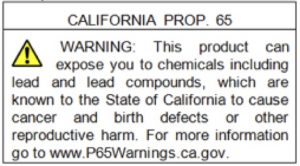
Turmoil of product environmental compliance coming for 2018-19
By Aury Hathout M.Env, certified environmental auditor at Enviropass
Electronics Regulations & Standards Engineering Environmental Supply Chain environmental compliance Environmental compliance EU RoHS lobal regulations restrictions think greenThink Green / Environmental Issues
As our attention turns to the hazards of wintery weather at this time of year, members of the electronics industry must begin to pay heed to a completely different type of storm that could rock our world in the coming months and years. Significant changes in environmental compliance are approaching and expected to impact the electronics industry here in Canada. The following are some of the elements of this global regulatory movement.
EU RoHS
First of all, the European Union Restriction of Hazardous Substances (EU RoHS) scope is wider than ever. Various product categories are now covered, from household to professional equipment, including most medical devices, monitoring and control instruments etc. A list of products that will be explicitly excluded is expected in the coming months. In other words, products that won’t clearly be listed will have to be EU RoHS compliant by default and CE marked accordingly.
Secondly, some EU RoHS exemptions will expire, such as the exemption 39-B – Cadmium in downshifting cadmium based semiconductor nanocrystal quantum dots for use in display lighting applications (< 0.2 μg Cd per mm2 of display screen area) – which will no longer be valid after June 30th, 2018. If you require your products to remain compliant, then you may consider looking for replacement parts that benefit from these exemptions that are about to expire.
A third major change is the addition of substances to the list of restrictions. Indeed, by passing the delegated Directive 2015/863 (referred to RoHS 3), the European Union has amended the annex II of Directive 2011/65/EU and has added 4 restricted phthalates, which are linked to public health issues such as cancer:
- Bis(2-ethylhexyl) phthalate (DEHP);
- Benzyl butyl phthalate (BBP);
- Dibutyl phthalate (DBP); and
- Diisobutyl phthalate (DIBP).
The restrictions of these phthalates in homogeneous materials of Electrical and Electronic Equipment (EEE) apply starting on July, 22nd 2019. Nevertheless, product categories 8 (medical devices) and 9 (monitoring and control instruments) are exempted until July 22nd, 2021 for these 4 phthalates. They are typically used as plasticizers and may be found in adhesives, inks, coatings, cables, polymer foils, PVC compounds or other plastic materials. Phthalates are especially present in computers, electronic and electrical equipment, optical products, machinery and transport equipment. The previous 6 restricted substances remain, i.e.:
- Lead (pb);
- Cadmium (Cd);
- Mercury (Me);
- Hexavalent chromium (Cr 6+);
- Polybrominated biphenyls (PBB); and
- Polybrominated diphenyl ethers (PBDEs)
A growing number of suppliers are already able to provide certificates of compliance for all the 10 restricted substances.
China RoHS
The Chinese Ministry of Industry and Information Technology (MIIT) has published a new China RoHS regulation called Management Methods for the Restriction of the Use of Hazardous Substances in Electrical and Electronic Products (Order 32). A Compliance Management Catalogue and a Conformity Assessment System are planned. The question looms over their implementation.
California Prop. 65
In the middle of the Silicon Valley, the California’s OEHHA (Office of Environmental Health Hazard Assessment) provides new warning requirements under the Proposition 65, as of August 30th, 2018, according to amendments of Article 6 of Title 27 – California Code of Regulations, Clear and Reasonable Warnings. 
Here is an example of the Prop. 65 label you may have to provide with the electronic equipment you export to California:
Conflict Minerals
Despite the amendments to the Dodd-Frank act and the step back on Conflict Minerals ban declarations at the Securities and Exchange Commission (SEC) in the USA, Europe takes over with Conflict Minerals regulations. The main target of these Conflict Minerals rules is to ensure sustainable imports of tin, tantalum, tungsten and gold (3TGs), i.e. banning both human rights abuses and armed conflict financing.
Spreading of Regulations Worldwide
Regulations similar to RoHS, REACH and WEEE (Waste of Electrical and Electronic Equipment) have recently multiplied worldwide. For example Bangladesh, California, the Eurasian Economic Union (EAEU), India, Singapore, Switzerland, Taiwan, Turkey, Ukraine, the United Arab Emirates (UAE) and Vietnam have either drafted or enacted regulations for electrical and electronic products environmental compliance. In order to be enforced, some of these regulations such as the UAE RoHS will require further clarifications.
The Brexit
The exit of the United Kingdom from the European Union has brought its share of uncertainties. What will happen to the harmonized regulations? Will the UK keep the same rules or adopt slight national deviations from the current state or implement new rules for REACH, RoHS etc.? One thing is certain, up to 2019, the same rules are going to apply in the UK as in the European Union. However, renegotiations will occur in 2019 at the earliest. The current UK government seems to be inclined to keep the same REACH and RoHS rules as the rest of the EU after Brexit. The future can only tell what the outcome of the renegotiations will be.
Conclusion
In Canada, we benefit from excellent opportunities to develop new products and spread them all over the world. The Comprehensive Economic and Trade Agreement (CETA) enables free-trade between Canada, the European Union and its Member States. Therefore, product environmental compliance is being a growing concern. In spite of this regulatory storm, it is time to leave confort zones, take risk and grasp the opportunity to surpass our competitors on new markets!
